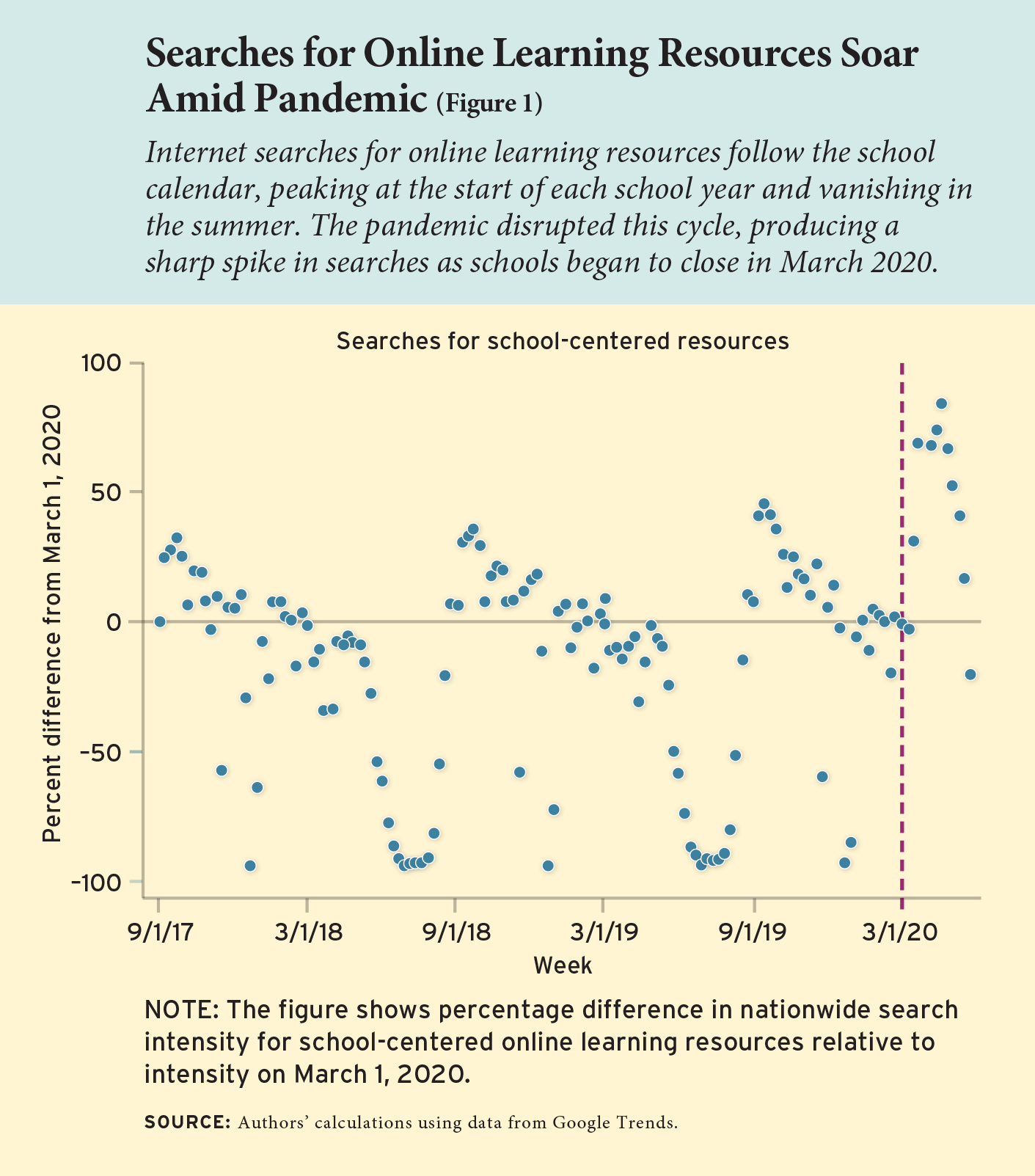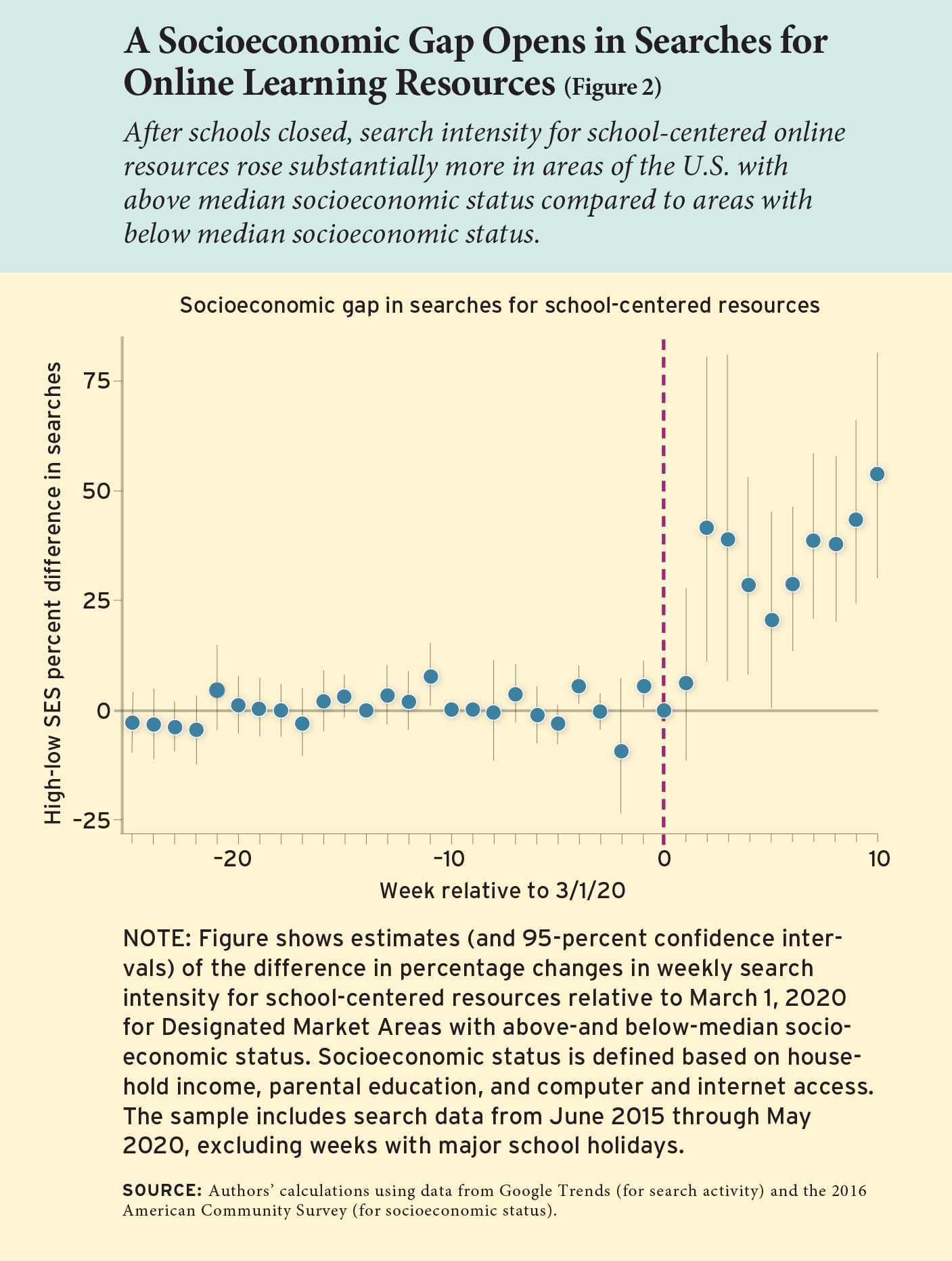
As states and districts consider how best to educate students this fall, it is critical to understand how the pandemic-induced school closures affected students’ engagement with online learning resources intended to compensate for lost time in school.
One way to do that is by using high frequency, nationally representative Google search data. These data allow us to document in real time how parents and students sought out online resources as schools closed in response to the Covid-19 pandemic. By comparing changes in online search activity across different geographies, we are able to estimate how Covid-induced demand for online resources varied by a range of geographic and socioeconomic factors, including income, internet access and rurality. The results of these comparisons are striking.
Pre-Covid searches for online learning resources fall largely into two categories, which we call “school-centered resources” and “parent-centered resources.” School-centered resources are platforms typically used by schools to provide instruction, assign work, or communicate with students (such as Google Classroom or Schoology). Parent-centered resources are more generic search terms indicating parents or students are likely seeking supplemental learning resources (such as homeschooling materials or math worksheets). Search intensity for school-centered resources dwarfs that for parent-centered resources. Both follow the school calendar, peaking at the start of each school year and vanishing in the summer.
The onset of Covid disrupted this usual cycle of search intensity, as the pandemic triggered a very large increase in demand for online learning resources. By April 2020, nationwide search intensity for online learning resources had roughly doubled relative to baseline (see Figure 1). Searches for both school- and parent-centered resources spiked, suggesting that increased demand for online support came not only from schools shifting their mode of instruction but also from parents and students seeking additional support as schools closed.
The pandemic also substantially widened socioeconomic gaps in searches for online learning resources (see Figure 2). Search intensity rose substantially more in areas with above median socioeconomic status (measured by household income, parental education, and computer and internet access) as in areas with below median socioeconomic status. Search intensity for school-centered resources, for example, increased by 15 percent for each additional $10,000 in average household income and by roughly 50 percent for each 10-percentage-point increase in the fraction of households with broadband internet and a computer. Areas with more rural schools and more Black students also saw lower increases in search intensity. Socioeconomic gaps widened both between and within the country’s four Census regions (Northeast, Midwest, South, and West).
These results reveal a new aspect of the digital divide, namely the extent to which households seek out online learning resources when in-person instruction is unavailable–either prompted by their schools or of their own accord. A large literature documents pre-Covid gaps in access to and proficiency in the use of digital technologies. Multiple post-Covid surveys show socioeconomic gaps in students’ reported engagement with remote learning. We complement this evidence with the first nationally representative measure of such engagement, based on households’ actual behavior rather than teacher or parent reports. The high frequency nature of the data reveals the evolution over time of engagement with online learning resources.
Socioeconomic gaps in engagement with online learning resources are not limited to a single platform or location but are a fundamental feature of the post-Covid landscape. Our findings provide insight into the mechanisms underlying learning losses that are beginning to emerge following this spring’s school closures and can help inform future policy responses to schooling disruptions, whether related to the pandemic or not. That search for school-centered resources increases more in high-income areas suggests either that those areas’ schools are using online platforms more, that those areas’ parents are more likely to engage with such platforms, or both. That search for parent-centered resources increases more in high-income areas suggests that, separate from schools’ actions, parents are differentially likely to seek out their own ways of compensating for their children’s lost learning time.
These results can help policymakers and school leaders formulate more effective responses to the educational disruptions caused by Covid-induced school closures. Students from lower income families and schools may require additional attention and resources given lower engagement with online learning resources during spring 2020. Moreover, because remote learning will remain a central feature of the public education system for the foreseeable future, preventing the widening of achievement gaps may require improving access to home computers and broadband internet for low-income and rural students. Schools may also need to improve the deployment of remote learning platforms to more equitably engage students and parents in the use of those platforms.
Whether efforts to close gaps in online learning engagement succeed will only become clear as new data become available in subsequent school years. One advantage of using publicly available search data to measure household behavior is that our analyses can be easily updated in real time when the school year begins in the fall. This will help reveal whether socioeconomic gaps in engagement with online learning have narrowed since the initial shock of schools closing or if different remote learning strategies across regions were particularly successful.
Household adaptation to schooling shocks is an understudied phenomenon that is readily apparent in internet search data. Understanding and accounting for such behavioral responses by parents and students will be critical to predicting the long-term effects of the pandemic, and, ideally, for preventing those effects from being worse than they would be in the absence of this data.
Andrew Bacher-Hicks is assistant professor of education at Boston University’s Wheelock College of Education and Human Development. Joshua Goodman is associate professor of education and economics at Boston University. Christine Mulhern is an associate policy researcher at RAND Corporation. Their working paper, “Inequality in Household Adaptation to Schooling Shocks: Covid-Induced Online Learning Engagement in Real Time,” is available here.
get headlines https://thecherrycreeknews.com

